
Image source: Huffington Post.
If you’re around the same age as this author, you may have recently had a child. If so, you may also be experiencing sticker shock. Hospital bills from the birth, doctors bills, diapers, clothes, books, toys, tiny baby-sized furniture, ointments, hooded towels…having a baby is expensive. And if you ever want to go somewhere without bringing your baby, you’ll need to hire a babysitter.
This makes leisure time expensive as well. Before you have a child, you might complain that going out for a movie is pricey. “$32 for two movie tickets, that’s highway robbery!” But after you have a kid, you have to pay someone around $60 to watch the child for a few hours if you want to see Oscar nominated films while they’re still in theaters. So, now it costs $92 for two people to go see a movie. Going out to dinner for a date? Restaurants that were cheap before you had a kid are suddenly expensive once you account for childcare costs.
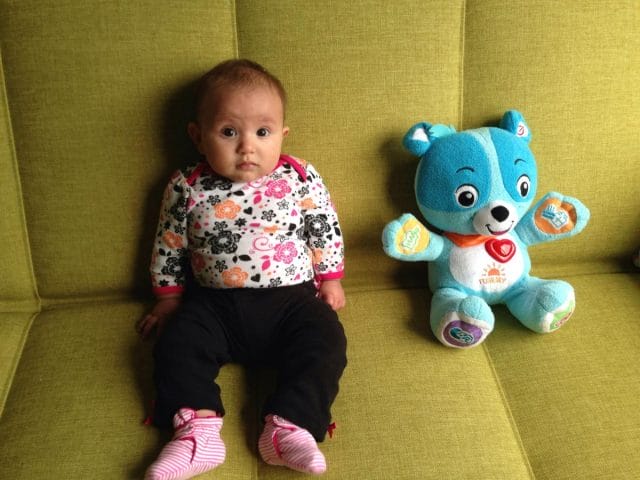
This author’s much-loved, but expensive daughter (on the left).
So, we thought we’d quantify this expense. How much exactly does a night of babysitting cost? Which cities’ babysitters charge the most? If you have a PhD and can’t find a job in academia, can you at least command a price premium as a babysitter?
But as we started the analysis, we realized something else. Almost none of the babysitters were men. You might not find that surprising. What we found shocking is that we almost didn’t even notice this gender disparity. Our bias that a “babysitter should be female” was so strong that we paged through hundreds of profiles without noticing that we didn’t see any men.
Only when we ran the analysis did we realize that only 2.9% of babysitters are men. Is there any other job with such gender disparity? Why does this imbalance exist and what does it say about the state of gender equality in America?
But first, how much does a babysitter cost?
We decided to crawl the web to find profiles of babysitters online and see how much they charged. While in the olden days, you might have hired your neighbor’s kid to babysit, today there are massive websites where babysitters can list themselves to get business. We scraped information such as their location, age, gender, education level, any certifications they have, and their hourly rate. We analyzed 175,000+ online babysitter profiles from the largest cities in the United States.
The median price for a babysitter in the United States is $14.50 per hour. This makes any activity you want to do without your kid quite expensive, no matter where you live. Across major American cities, the median ranges from $12.00 per hour to $17.50 per hour.
Where’s the most expensive city to get a babysitter in the United States? We have a tie between San Francisco and New York.
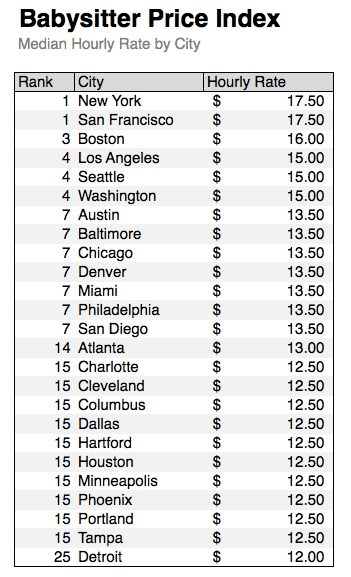
Source: Priceonomics Data Crawling
We didn’t look into the prices of babysitters in smaller cities or in the suburbs, but in the largest American cities, babysitters charge the least in Detroit. You can get pretty much the cheapest everything in Detroit actually.
Finally, your graduate degree pays off! Sort of.
Next, we look at how much babysitters charge based on their stated level of education. At last, those hundreds of thousands of dollars you invested in your education come in handy! People with a graduate degree charge $4.50 more per hour than those with just a high school diploma. College graduates charge $2.50 more than high school graduates.
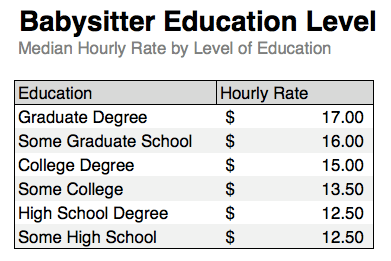
Source: Priceonomics Data Crawling
High school dropouts and high school graduates make about the same amount.
So, you’re armed with your newly minted undergraduate degree in Psychology. Did you know the top area of study among babysitters is Psychology?
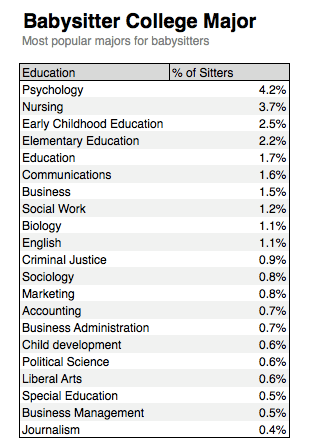
Source: Priceonomics Data Crawling
Also worth noting, we found that babysitters certified in CPR charge $1.00 more and those with First Aid training charge $0.50 more than those without any medical training.
Babysitting: A profession for the young, but not too young.
Most online sites won’t allow you to advertise your babysitting services if you’re underage, so our data excludes the market of 12 year olds who no doubt provide discounted babysitting services. Among those advertising online, however, the median age is 24.
However, 78% of babysitters are 30 or younger and 89% of them are 40 or younger. Older babysitters are either less common or, if they exist, less likely to advertise online.
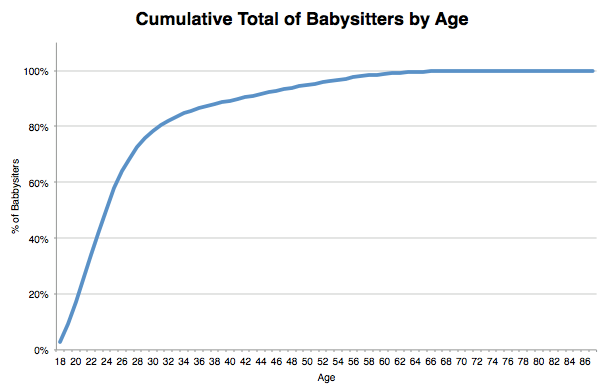
Source: Priceonomics Data Crawling
While most babysitters are on the younger side, there is a sweet spot in terms of commanding premium prices: not too young, not too old, but just right.
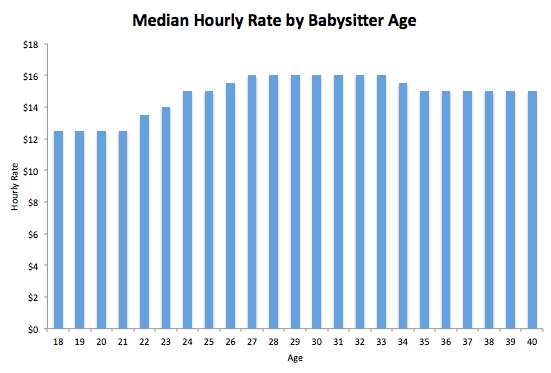
Source: Priceonomics Data Crawling
Have you ever met a male babysitter?
Finally, we turn to the data on the babysitter gender gap. A whopping 97.1% of babysitters are women and 2.9% are men. Here is a somewhat unnecessary pie chart to prove that most babysitters are women.
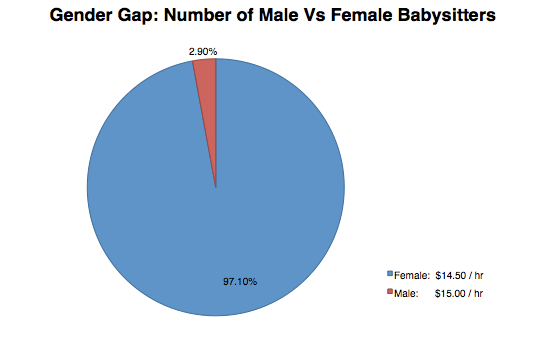
Source: Priceonomics Data Crawling
Interestingly, the median male babysitter charges $15.00 per hour while the median female babysitter charges $14.50. A growing body of literature posits that one of the reasons that men make more money than women is that they’re overconfident in their own skills. Even in an industry like babysitting where men are likely discriminated against, they still try to charge more for their services!
How strong is this bias against male babysitters? Let’s look at the babysitting website Sittercity.com. By default, the company *only shows female babysitters* in their search results. Unless you physically go into advanced search settings and change the gender to “either” or “male,” you won’t see any men in your search results. When is the last time you toggled through advanced search settings? To their credit, Care.com, another large babysitting website, shows male and female profiles in their search results.
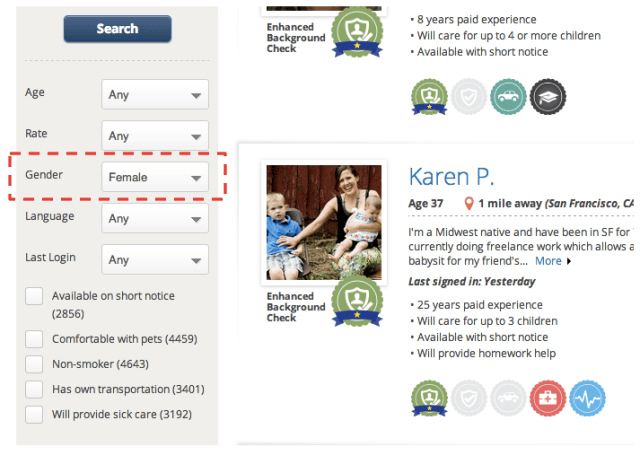
Screenshot of Sittercity San Francisco results. See if you can figure out how to get to this from here.
Conclusion
“I personally would have a hard time hiring a male babysitter for obvious reasons. The question though is how fair is that?”
-Katherine, Mother in a Parenting Forum
Well Katherine, the answer is it’s not very fair. But is the root cause of the male babysitter shortage a demand side or supply side issue? Like Katherine, do potential buyers of babysitting services discriminate against men? Or are men less likely to supply babysitting services because of a social stigma? The answer is likely both.
For a society that aims to have gender equality, it seems pretty bad that professions involving the care of children are strictly “female.” Is there any good reason why half of babysitters shouldn’t be men? We can’t think of one rationale for the scarcity of male babysitters that isn’t rooted in outdated norms about gender roles. We all have biases, but the stereotype that childcare is a job for women remains a very strong one.
This post was written by Rohin Dhar. Follow him on Twitter or Google Plus. Data crawling by Brendan Wood. To get occasional notifications when we write blog posts, sign up for our email list.



